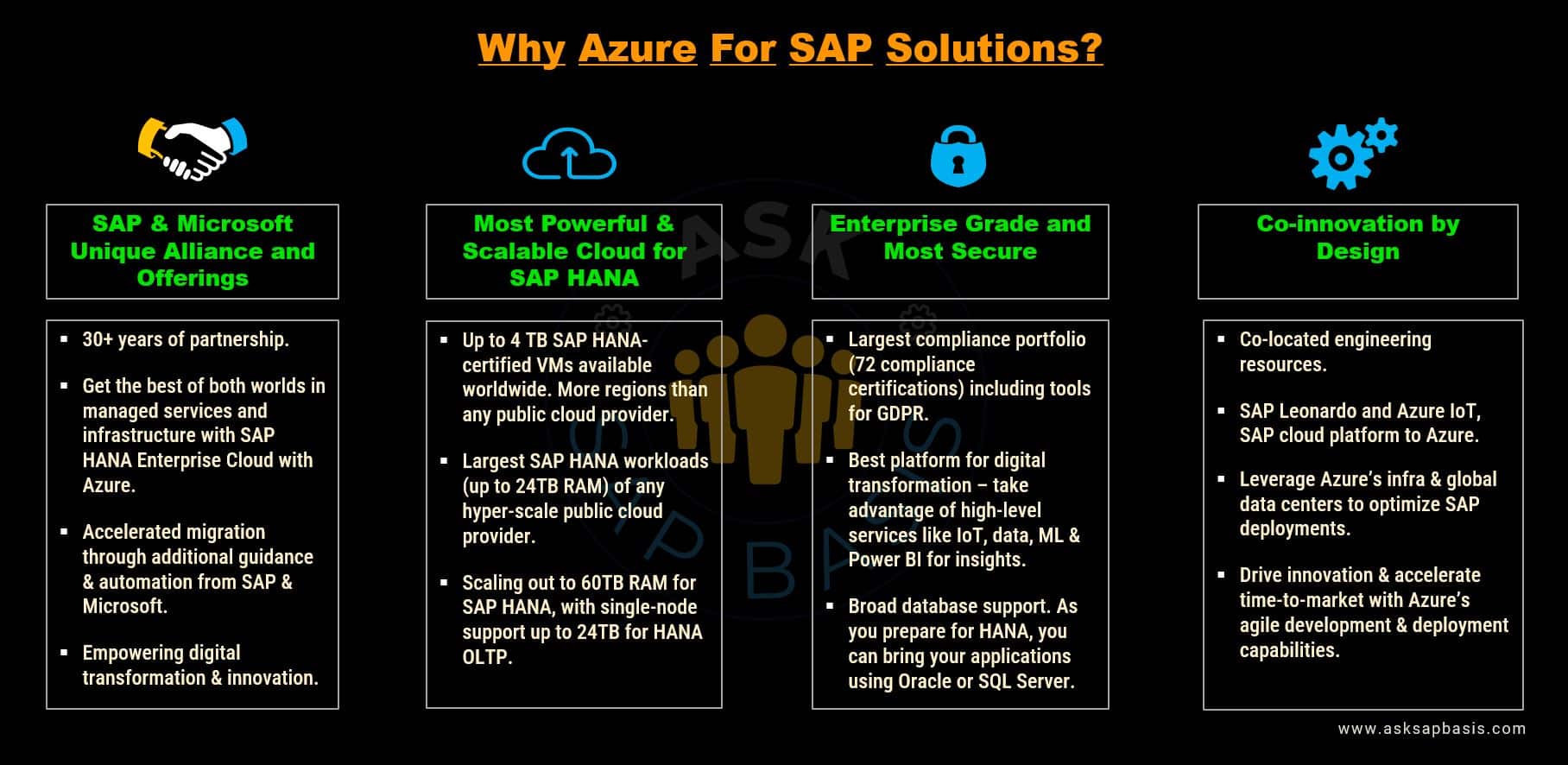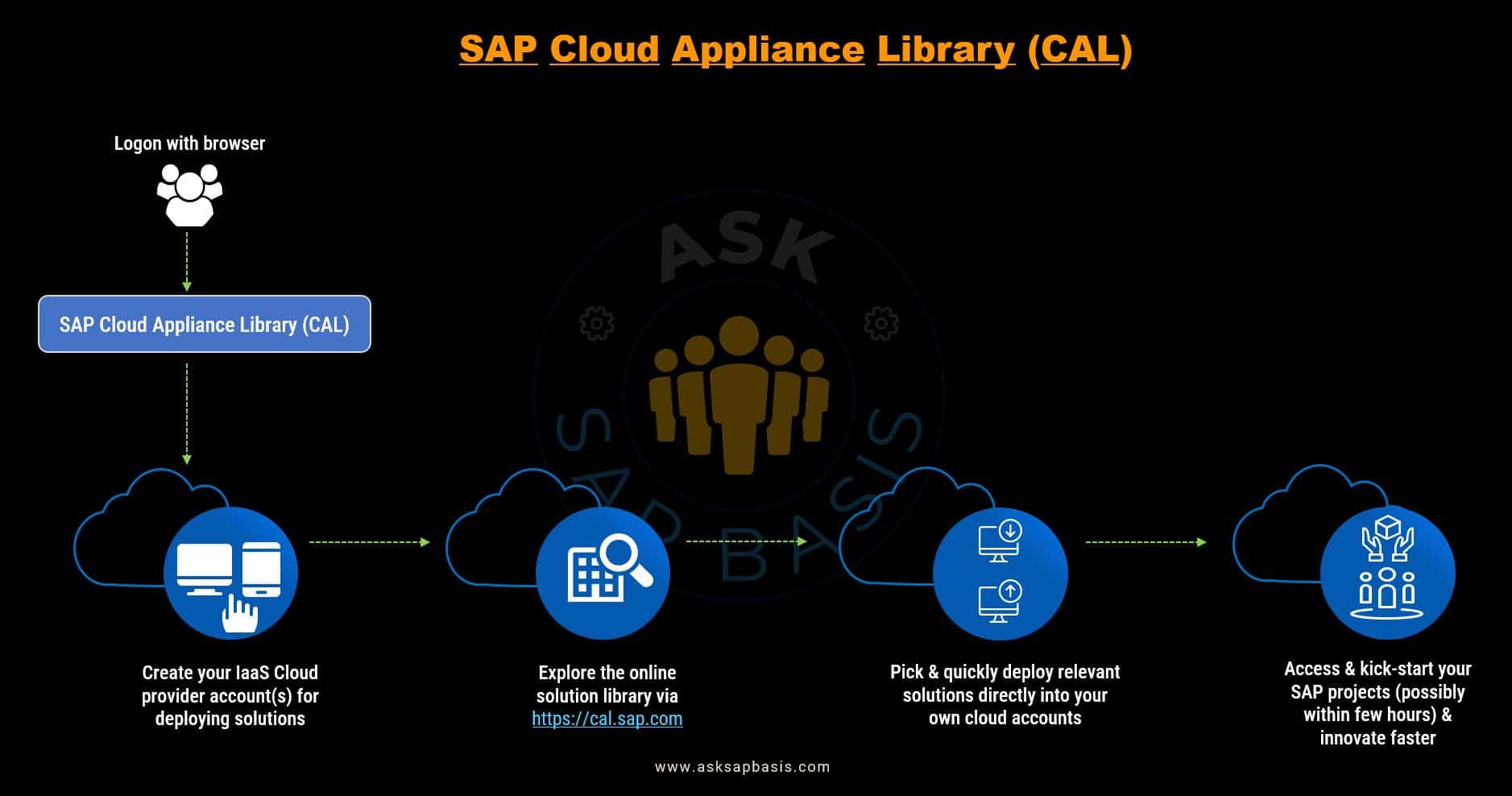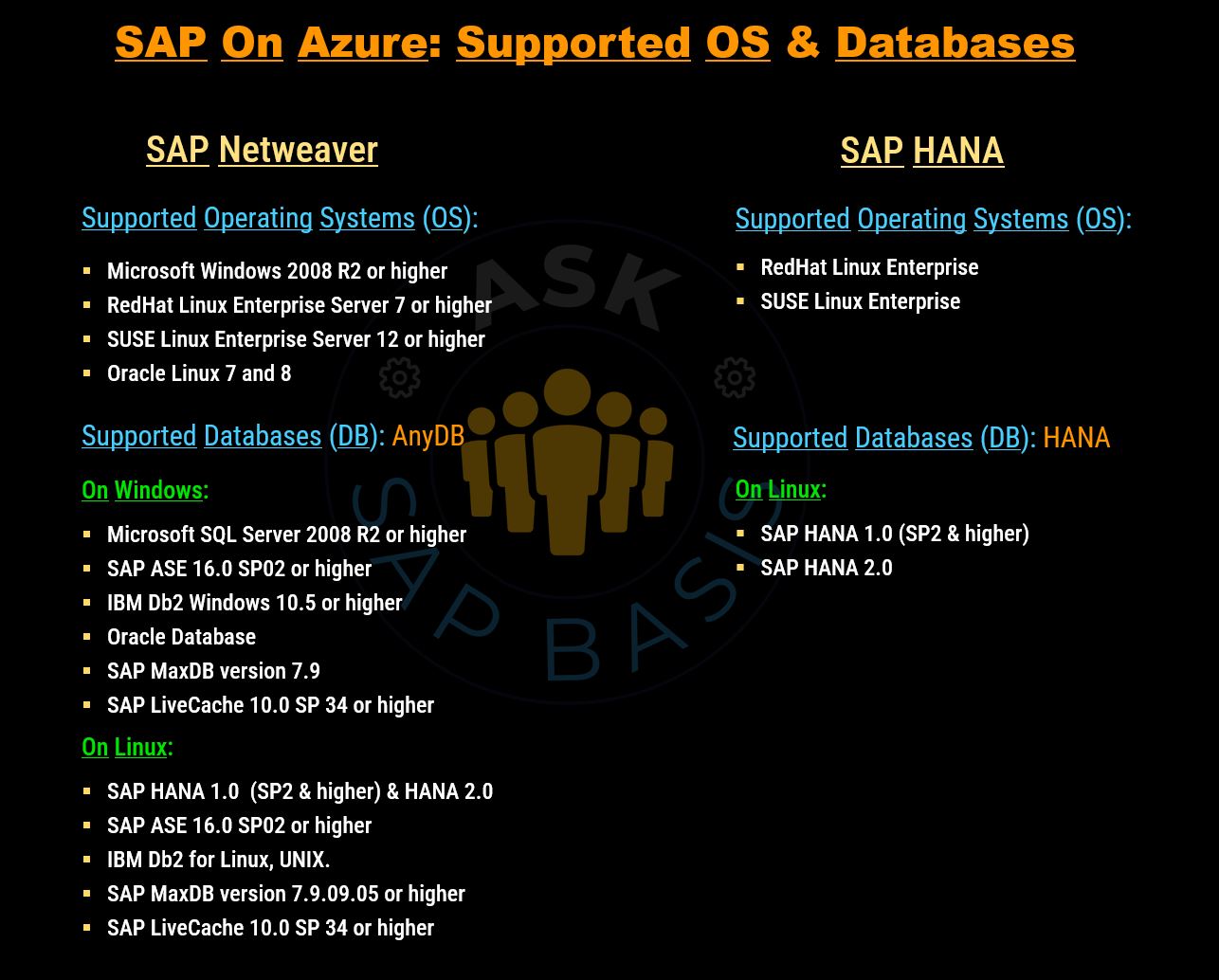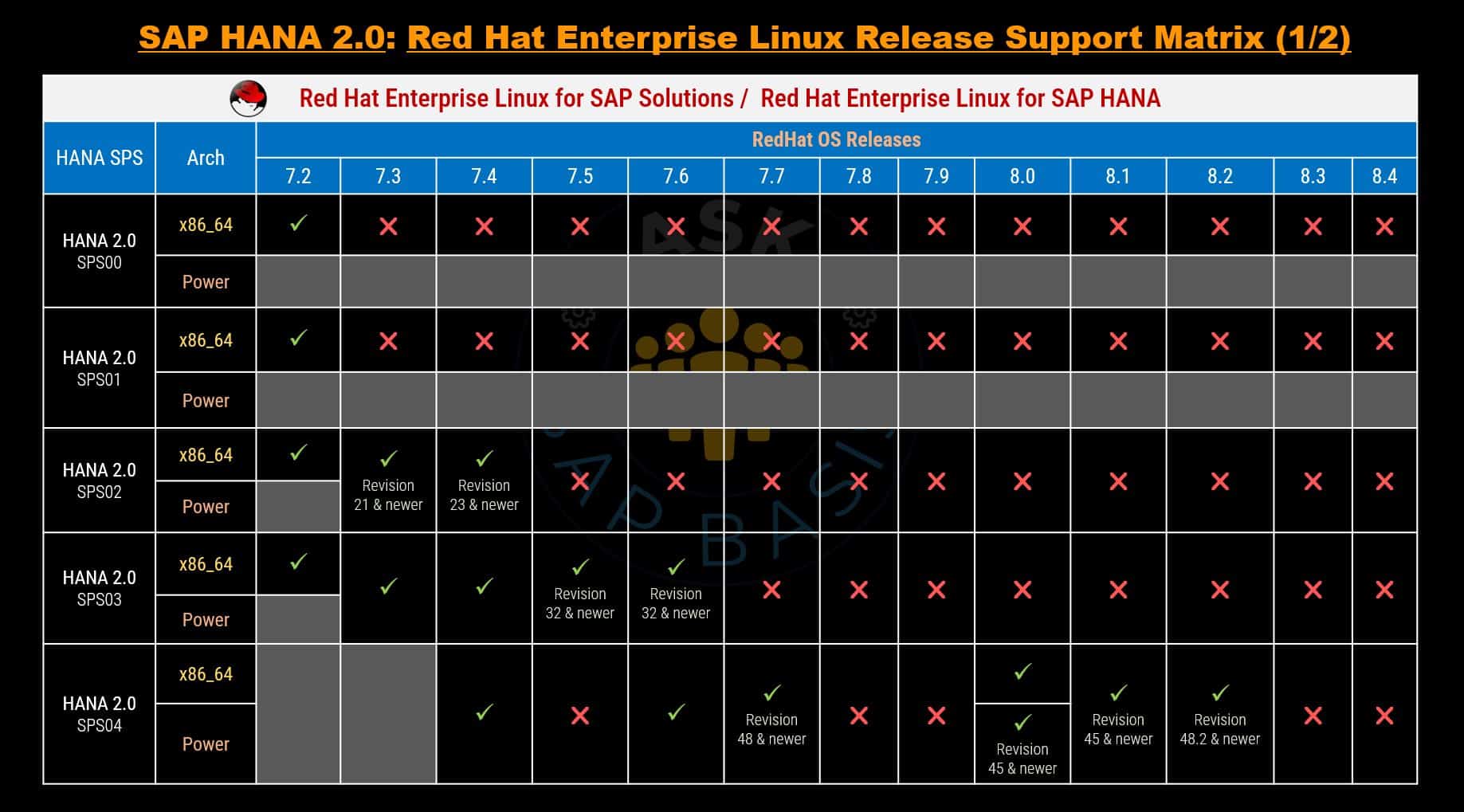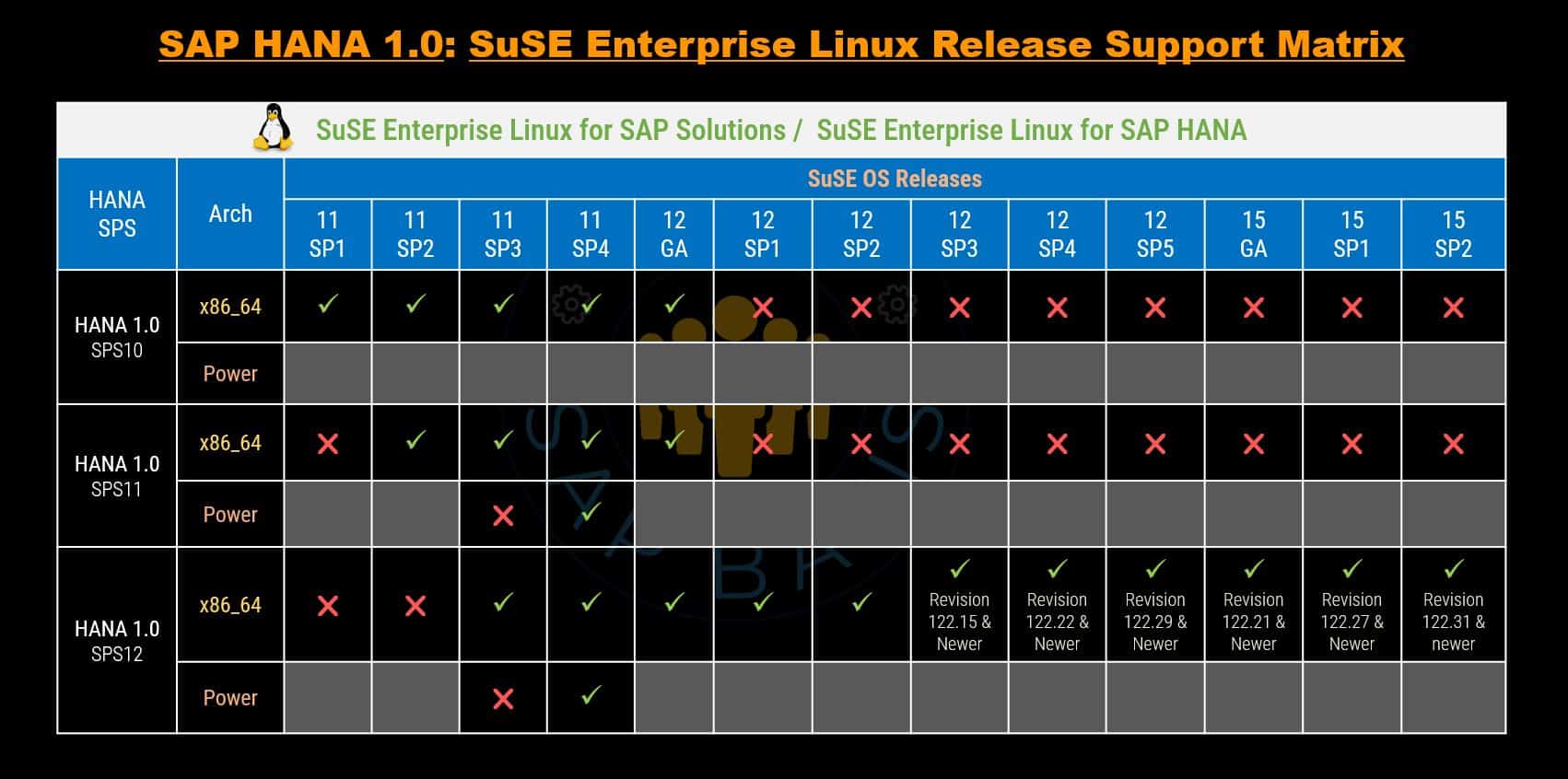SAP on Azure – Beginner’s Guide for 2025
Overview
In today’s business landscape, SAP serves as the backbone for many organizations, and its unavailability can severely disrupt operations and hinder customer responsiveness. The traditional reliance on on-premises IT systems is becoming a thing of the past, giving way to the growing trend of co-location facilities and cloud-based solutions.
For most organizations, SAP is the core business system. Concerns about the scalability and feasibility of running such critical systems in the public cloud are understandable. However, the shift away from purely on-premises IT systems has paved the way for co-location facilities and cloud solutions. Today, companies recognize the benefits of cloud-based scalability, agility, and cost-efficiency.
Leading cloud providers like Azure prioritize security, data protection, and compliance, making the migration of SAP to the cloud a strategic move. By leveraging cloud solutions, organizations can achieve greater flexibility and scalability, allowing IT teams to focus on more strategic initiatives.
A well-planned migration strategy, backed by robust backup plans, ensures business continuity. Embracing public cloud solutions empowers organizations to optimize their operations and remain competitive in an ever-evolving market.
Why are businesses moving SAP to the Cloud?
Some of the key quantified reasons identified are:
- Cost Savings: Avoid the expense of on-premises hardware and over-provisioned resources.
- Faster Time to Market: Accelerate SAP release cycles and updates.
- Resource Optimization: Reduce the need for staff reallocation to manage SAP infrastructure.
- Space Efficiency: Eliminate the need for physical data center space.
Discover the power of combining SAP and Azure in this comprehensive guide. Explore the benefits, best practices, and the unmatched scalability, security, and flexibility that Azure offers to optimize your SAP deployments. Get ready to embark on a transformative journey and unlock new possibilities for your business with SAP on Azure.
Why SAP on Microsoft Azure?
SAP and Microsoft have forged a robust partnership over the years, bringing mutual benefits to their customers. Microsoft, as a stalwart technology giant, consistently enhances its platform and proactively provides SAP with up-to-date certification information. This collaborative effort solidifies Microsoft Azure as the premier choice for running SAP workloads.
Experience an expanded collaboration between these two industry leaders. Deploy SAP applications confidently across various scenarios in Azure and Microsoft components. Enjoy comprehensive support throughout your SAP journey.
Benefits of Azure Hosting
Some of the benefits of running SAP applications on Azure are:
- Highly Available, On-demand and Scalable: Azure offers SAP-certified infrastructure with on-demand, scalable compute resources and a pay-per-use model, allowing businesses to adjust resources based on needs.
- Security and Compliance: Azure’s extensive certifications portfolio, unmatched by other public clouds, ensures secure hosting with encryption, Azure Security Center, and Azure Active Directory for robust data protection.
- Global leader: With its expansive global scale, Azure surpasses any other cloud providers, boasting an extensive footprints of 60+ regions. This unparalleled reach empowers organizations to optimize their operations for exceptional user experience, while adhering to local data residency requirements.
- Extensive Ecosystem: Azure’s broad ecosystem of partners and third-party solutions integrates seamlessly with SAP, enhancing functionality and providing added value.
- Cost Efficiency: Azure reduces costs by up to 60% compared to on-premises storage, with potential TCO savings of 40-75% in development and testing environments.
- Resiliency: Azure ensures enterprise-grade resilience with redundancy, geo-replication, and a 99.99% SLA.
- Advanced Services and Innovation: From AI and analytics to IoT, Azure’s advanced tools enhance SAP deployments, driving innovation and unlocking insights.
Overall, choosing SAP on Azure offers organizations a powerful, flexible, and secure platform to run their SAP workloads, with the added benefits of scalability, performance, cost optimization, and access to advanced services and innovation.
Terms and Terminology
- Landscape: Your SAP assets, including production and non-production environments making up the entire IT landscape.
- SAP System: An SAP system comprises the DBMS layer and application layer. For example: SAP ECC development system, SAP Portal production system etc.
- Environment: It consists of logically grouped SAP components performing various business functions, such as development, quality assurance, training, production or disaster recovery environments.
- Components: SAP applications such as, ERP Central Component (ECC), Enterprise Portal (EP), Business Intelligence (BI) etc are individual components. These components can be built on traditional ABAP or JAVA technologies, or they can non-NetWeaver based applications like Business Objects.
- AnyDB: It refers to any non-HANA third-party database that has been selected to power the SAP system.
- VM’s: It is referred to Azure’s Infrastructure as Service (IaaS) virtual machines (VMs).
- Azure Region: An Azure region consists of multiple datacenters deployed within a defined perimeter, ensuring low latency connectivity through a dedicated regional network.
- Azure Datacenter: It encompass distinctive physical structures distributed across the world, serving as homes to interconnected groups of computer servers.
- SKU (Stock Keeping Unit): It is a unique identifier assigned to a specific product or item in inventory management. It is used to track and manage inventory, facilitate sales transactions, and enable efficient stock control.
Pre-requisites for SAP on Cloud
Before embarking on your SAP journey in the cloud, its crucial to ensure you meet the necessary prerequisites for a successful deployment. Here is a comprehensive list of prerequisites to consider:
- Valid SAP Software Licensing: Ensure you have the appropriate SAP software licenses for running SAP on a cloud-based Infrastructure as a Service (IaaS) environment. This licensing is essential for compliance and legality.
- SAP Sizing and Resource Requirements: Perform thorough SAP sizing to determine the resource requirements for your SAP workloads. This includes understanding the CPU, memory, storage, and network needs specific to your SAP environment.
- Certified VM Instances: Familiarize yourself with the certified VM instances required for running SAP workloads on your chosen cloud IaaS provider. Verify that the cloud provider offers reliable capacity and performance that aligns with your SAP requirements.
- Network Evaluation: Test and evaluate network connections comprehensively. This includes assessing factors such as latency, bandwidth, and packet loss between various infrastructure components. Ensure seamless connectivity between on-premise locations, data center regions, and any other interconnected elements.
- Certified Operating Systems: Have a clear understanding of the certified operating systems that can effectively work in tandem with SAP software. This ensures that the operating system you choose is compatible and optimized for SAP workloads.
- Expertise in SAP and Cloud: Possess the necessary expertise in SAP system operational aspects. You should also demonstrate familiarity with the cloud provider’s infrastructure, especially in relation to the shared responsibility model. This understanding is vital for effective management and troubleshooting.
- Support Services Awareness: Be knowledgeable about the support services provided by your chosen IaaS provider. Understanding the support options available can be critical in times of troubleshooting or system maintenance.
- Support Agreement: Establish a support agreement with your chosen cloud service provider. This ensures that you have access to the necessary assistance and resources from the provider when needed, enhancing the reliability of your SAP deployment.
By meeting these pre-requisites, you’ll be well-prepared to deploy SAP on the cloud with confidence. Ensuring compliance, technical readiness, and a clear understanding of the responsibilities involved are key steps in a successful transition to a cloud-based SAP environment.
SAP Solutions on Azure
Deployment Planning
Let’s delve into a strategic deployment plan that ensures seamless integration and optimal performance.
Understanding the Cloud Distinctions
The first crucial step is to understand the distinction between the offerings of the traditional hosting providers or outsourcing firms and cloud-based IaaS solution. The traditional hosting providers or outsourcing firms customize the infrastructure (ie servers types, network and storage etc) to meet customer’s desired workload requirement. But in cloud-based IaaS deployments, it is the responsibility of the customer or partner to identify the workload requirements and selecting the appropriate Azure components, such as VM, network and storage.
Adhering to SAP Certified Configurations
Compliance with SAP certified configurations on Azure is essential for customers to ensure successful implementation of SAP workloads on Azure. These configurations encompass a harmonious blend of the following four crucial elements:
- SAP Product
- Operating System
- RDBMs
- Virtual Machine (VM) SKUs
For a successful deployment of an SAP system on Azure, customers needs to actively ensure that the application hosting components align with the Azure support matrix. It fits within the available resources of the Azure infrastructure, and seamlessly integrate with Microsoft Azure provided availability service level agreements (SLAs).
Step #1:
Before deployment, assess the following requirements:
- Azure VM’s types supported by SAP.
- SAP supported products/releases on Azure.
- Supported OS and DBMS combinations for specific SAP products in Azure.
- SAPS throughput and storage types provided by different Azure SKU’s.
SAP Note 1928533 is a valuable resource to answer all the above questions. The note contains up-to-date listing of supported Azure VM SKU’s for serving your SAP workloads.
Step #2:
As next step, compare the Azure resources and bandwidth limitations with the actual resource consumptions of on-premise systems. To do so:
- Determine the SAPS requirement for a given SAP system. (SAPS requirements for both DB and app layer needs to be separately considered). SAPS metrics evaluates whether a VM size meets the required throughput for a given workload.
- Based on the SAPS rating and current resource utilization, Azure VM requirements can be derived.
- Obtain IOPS for the current SAP database and based on DB size & disk growth, Azure storage requirements can be derived.
- Map the derived SAPS and IOPS requirements against SAP Note 1928533 to determine the require Azure VM types and storage types supported by SAP.
- Validate different capabilities of the Azure resource types supported with SAP in the area of:
- CPU and memory resources of different VM types.
- IOPS bandwidth of different VM types.
- Network capabilities of different VM types.
Step #3:
In the final step, assess the availability requirements.
- It is important to note that Azure regions may vary in their offerings or availability of specific VM SKUs, providing diverse range of options to choose from. However, it’s vital to exercise due diligence to ensure compatibility of Azure VM types with SAP applications.
- By diligently evaluating these factors, you can ensure a robust and reliable infrastructure for running SAP workloads on Azure.
By meeting these requirements, you can confidently deploy the SAP systems on Azure and ensure seamless operation. Please find more details on SAP certifications for running on Microsoft Azure.
Deployment Methodologies
The resource deployment methodologies refers to various approaches and techniques used to deploy SAP solutions on the Azure cloud platform. These methodologies outline the specific methods, tools, and processes that organizations can employ to effectively and efficiently deploy their SAP workloads on Azure.
When it comes to deploying SAP on Azure, it offers an array of impressive methodologies at your disposal. Lets explore few of the most common ones:
- Azure Portal: It is an intuitive graphical user interface (GUI), that empowers you to to effortlessly deploy and manage resources through a seamless web-based interface. This user-friendly approach simplifies the process of resource management.
- Azure PowerShell: Automation takes the center stage with Azure PowerShell. It is a versatile command-line tool that enables the scripting and automation of Azure deployments. Through the power of PowerShell scripts, you can orchestrate and streamline your deployment processes with easy and efficiency.
- Azure CLI: The Azure Command-Line Interface (CLI) serves as a dynamic cross-platform tool, that unleashes the command line prowess for interacting with Azure resources and executing deployments. This versatile interface allows for efficient and flexible deployments workflow across different operating systems.
- Terraform: Step into the world of infrastructure-as-code (IAC) with terraform. It is an open-source tool designed to define and manage infrastructure deployments using declarative configuration files. With Terraform, you can orchestrate complex SAP deployments with precision and scalability, leveraging the benefits of IAC.
- ARM Templates: ARM (Azure Resource Manager) templates are JSON files that determine the desired state of Azure resources for deployment and management. They are a declarative way to describe the infrastructure and configuration needed to define, manage and support an application or workload on Azure cloud platform. By defining your infrastructure in a template, you can ensure consistent deployments and enforce compliance with organizational standards and policies.
- Azure SDK: Azure SDK (Software Deployment Kit) is a set of libraries, tools and resources provided by Microsoft Azure to facilitate the deployment of applications that interact with Azure services. Azure SDK supports multiple languages and frameworks, including but not limited to – Java, C#, Node.js, PHP, Ruby, Python, and Go.
- Azure REST API: Azure REST API enables developers to programmatically create, configure and manage Azure VMs. It is a language agnostic platform, providing developers higher level of abstraction.
With these some of the versatile deployment methodologies, you have the flexibility and control to effortlessly orchestrate your SAP deployment on Azure, ensuring a smooth and successful deployment experience.
SAP Deployment Options
Customers have various deployment options available when implementing SAP products in Azure.
1) Azure Virtual Machines (VMs)
Azure Virtual Machines offer a higher degree of flexibility and control over your SAP landscape. With this deployment option, you can customize the VM configurations to meet your specific requirements and easily scale resources as needed.
You can explore the growing selection of certified Azure VM SKU’s (Stock Keeping Units) suitable for hosting SAP HANA, Netweaver as well as various non-SAP HANA and non-Netweaver based products. A comprehensive list of SAP-certified VM’s can be found in SAP Note 1928533.
Azure offers two services that can be utilized for running SAP HANA database.
- Azure Virtual Machines
- HANA Large Instances (HLI)
To run SAP HANA effectively, it is essential to use one of the following Enterprise Linux distributions products, as specified below:
- Red Hat Enterprise Linux for SAP Solutions
- Red Hat Enterprise Linux for SAP HANA
- SUSE Linux Enterprise Server for SAP Applications
- SUSE Linux Enterprise Server
SAP strongly recommends to use “RHEL for SAP solutions” or “SLES for SAP applications” due to their features and extended support cycles.
2) SAP Cloud Appliance Library (CAL)
SAP CAL is a user-friendly web-based tool designed to simplify the deployment of pre-configured SAP solutions on various public clouds, including Azure. It boasts a comprehensive library of SAP applications and configurations.
One of the key benefit of SAP CAL is its ability to simplify the deployment and testing of pre-configured solutions provided by SAP. This eliminates the need of manual provisioning of underlying infrastructure, making the process more efficient and convenient.
3) RISE with SAP S/4HANA Cloud
RISE with SAP is an integrated offering that combines S/4HANA Cloud and SAP Enterprise Cloud Services, provided by SAP for your SAP landscape. These services are conveniently packaged within an Azure subscription that is owned by SAP.
With RISE, you can can migrate your SAP landscape to the cloud and leverage SAP’s intelligent technologies and best practices. It offers a unified subscription model that covers software licenses, infrastructure, and services, simplifying the procurement and management of your SAP environment.
For more details you can refer to the documentation on integrating Azure with SAP RISE.
SAP Supported OS & DB Combinations
When deploying SAP systems in Azure, it is imperative to ensure compatibility between the operating system (OS) and the database (DB) used. SAP provides a comprehensive list of supported OS and DB combinations to ensure optimal performance, stability, and supportability of the SAP environment.
Azure IaaS services only support SAP workloads on x86-64 or x64 hardware, excluding Sparc and Power CPU architecture. If the customers current run their applications on proprietary operating systems like IBM mainframe, AS400, HP-UX, Solaris, or AIX, they must migrate their SAP applications, including the DBMS, to one of the recommended operating systems.
Additionally, you need to check the following points:
- Check if your SAP applications meet the minimum required releases. If not, define a new target release and consult the SAP Product Availability Matrix (PAM) for supported OS and DB combinations for new releases.
- Assess the need to update the SAP kernels during the migration to Azure.
- Evaluate whether you need to update SAP support packages (especially SAP Basis support packs), when migration to a newer DBMS releases.
SAP HANA: Supported OS Releases
SAP Supported Application Certifications
HANA Certifications
| SAP Product | Supported OS | Azure Offering | Azure VM Types |
| SAP S/4 HANA | Red Hat Enterprise Linux, SUSE Linux Enterprise | Certified and Supported SAP HANA® Hardware | M32ls, M32ts, M64s, M64ls, M64ms, M128s (scale-out), M128ms, M208s_v2, M208ms_v2 |
| Suite on HANA, OLTP | Red Hat Enterprise Linux, SUSE Linux Enterprise | Certified and Supported SAP HANA® Hardware | |
| SAP BW/4 HANA | Red Hat Enterprise Linux, SUSE Linux Enterprise | Certified and Supported SAP HANA® Hardware | GS5 M32ls, M32ts, M64s, M64ls, M128s, M128ms, M208s_v2, M208ms_v2 |
| HANA Enterprise for BW, OLAP | Red Hat Enterprise Linux, SUSE Linux Enterprise | Certified and Supported SAP HANA® Hardware | |
| Business One on HANA | SUSE Linux Enterprise | Certified and Supported SAP HANA® Hardware | DS14v2, M32ls, M32ts, M64ls, M64s |
Netweaver Certifications
| SAP Product | Guest OS | RDBMS | Virtual Machine Types |
| SAP NetWeaver | Windows, SUSE Linux Enterprise, Red Hat Enterprise Linux, Oracle Linux | SQL Server, Oracle (Windows and Oracle Linux only), DB2, SAP ASE | A5 to A11; D11 to D14; DS11 to DS14; DS11_v2 to DS15_v2; GS1 to GS5; D2s_v3 to D64s_v3; E2s_v3 to E64s_v3; M-series |
| SAP Business Suite | Windows, SUSE Linux Enterprise, Red Hat Enterprise Linux, Oracle Linux | SQL Server, Oracle (Windows and Oracle Linux only), DB2, SAP ASE | |
| SAP Business All-in-One | Windows, SUSE Linux Enterprise, Red Hat Enterprise Linux, Oracle Linux | SQL Server, Oracle (Windows and Oracle Linux only), DB2, SAP ASE | |
| SAP BusinessObjects BI | Windows | N/A |
Other SAP Workloads
| SAP Product | Guest OS | RDBMS | Virtual Machine Types |
| SAP Business One on SQL Server | Windows | SQL Server | SAP Note #928839 |
| SAP BPC 10.01 MS SP08 | Windows and Linux | N/A | SAP Note #2451795 |
| SAP Business Objects BI platform | Windows and Linux | N/A | SAP Note #2145537 |
| SAP Data Services 4.2 | N/A | SAP Note #2288344 | |
| SAP Hybris Commerce Platform | Windows | SQL Server, Oracle, SAP HANA | Hybris Documentation |
| SAP (Hybris) Commerce Platform 1811 and later | More recent versions of SLES 7, RHEL 7, Windows | SQL Azure DB | Hybris Documentation |
| SAP Content Server 6.5 or higher | More recent versions of SLES 7, RHEL 7, Windows | MaxDB 7.9.09.05 or higher | |
| SAP TREX 7.10 | More recent versions of SLES 7, RHEL 7, Windows | N/A |
Best Practices for Planning SAP Workloads To Azure
To ensure a successful and efficient migration, it is crucial to follow certain best practices when moving SAP workloads to cloud. Highlighted below are some of these:
Discovery Assessment
1) Evaluate Your SAP Environment
As a first step towards preparing for cloud migration, it is crucial to assess the complexity and elasticity of your SAP environment.
- This assessment includes evaluating workload complexity, underlying infrastructure, fluctuating scalability needs and database sizes to consider a few. This enables you to understand the intricacies involved in migration process. This involves analyzing the dependencies, interconnections and specific configuration of your workloads.
- Assess the compatibility and readiness of your infrastructure for migration to an cloud-based IaaS environment. Consider factors such as network connectivity, storage capabilities and compute resources to ensure they meet the requirements of your SAP workloads.
- When evaluating the requirements for seasonal elasticity, analyze the workload patterns and determine, if your SAP environment experiences significant fluctuations in demand during specific periods. This helps you choose appropriate IaaS solution that can scale resources up and down dynamically, ensuring optimal performance and cost efficiency.
2) Cleanup Your Closet
Identify your SAP system (underlying infrastructure) and applications (including third-party) dependencies to understand their relationship and communication. This allows you to take informed decisions, streamline your SAP workloads and optimize your system effectively.
This step is crucial as it helps you:
- Choose what to retire: Assess if there are any SAP workloads running on old or legacy hardware that are rarely used or have limited user access. Consider consolidating those application roles to streamline and optimize your SAP workloads.
- Choose what to replace: Explore software-as-service (SaaS) options to replace certain systems. For instance, SAP offers SaaS solutions like Concur, SuccessFactors, Ariba etc.
3) Right-Size Your Virtual Machines
Overprovisioning virtual machines (VM) can be a common pitfall.
- To ensure efficient resource allocation, it is advisable to take a proactive approach and aggressively right-size your virtual machines initially.
- By starting with an optimal size based on workload requirements, you can avoid the hassle of frequent resizing.
- Striking the right balance between resource allocation and scalability is crucial to achieve an optimized environment that meets your needs without unnecessary overhead.
4) Plan Your Azure Region
When migrating to Azure, plan your region strategy wisely.
- Choose regions that offer optimal connectivity for your organization and consider disaster recovery framework for a robust framework, that safeguards your business from potential disruptions.
- Azure region offers global reach. By strategically selecting the appropriate, Azure region or regions, you can optimize performance, minimize latency and ensure compliance with data sovereignty requirements.
Migrating SAP to the Cloud
5) Leverage Horizontal and Vertical Strategy Approach
- Horizontal strategy involves a phased approach, where SAP systems are migrated tier-by-tier, starting from the lowest tier environment before moving up the stack.
- It begins with sandboxes, then progresses to development system, followed by test systems and finally disaster recovery and production systems.
- This reduces risk and minimizes the impact on users and critical business functions. Also, gain experience before moving to higher impact systems.
- This approach expedited the migration numbers and established the necessary processes from the bottoms up.
- Vertical strategy involves selecting low business impact SAP systems first along with their complete tier environments. Each SAP system represents a business function role (for example SAP ERP, SAP BI etc).
- This extends an opportunity to adjust your internal processes for Azure, ensures seamless transition, valuable insights and quick learnings.
- It also serves as an valuable means to proactive identify any production issues early on.
- This approach enabled the team to define production processes, accelerate learning and efficiently manage tasks like patching, resizing and maintenance.
6) Optimize Migration Strategies For Your Environment
To execute a structured and successful migration of SAP to Azure, follow this simple strategic steps:
- Plan your migration strategy:
- Carefully consider what needs to be moved and when, utilizing practical guidance approach such as horizontal and vertical strategy.
- Maintain an accurate inventory:
- Actively build an accurate inventory of your SAP infrastructure, documenting and tracking the systems, components, and configurations involved in the migration.
- This inventory will help you effectively manage the migration process, allocate resources efficiently, and avoid any oversights.
- Exclude retired systems:
- Additionally, ensure that you exclude retired systems from the migration, so that you can focus only on the relevant and active components of your SAP environment.
- Disaster Recovery Plan (DR):
- Implement a reliable DR plan and thoroughly test your disaster recovery mechanism to ensure they are functioning as expected.
- Implement a robust fallback plan to mitigate any potential disruptions during the migration process.
7) Aligning With Critical Business Events
- When planning your migration, it is crucial to consider business-critical event and schedule the migration around them.
- Take into account significant events such as product releases, quarterly financial reporting, and projects going live in production environment.
- By planning strategically and avoiding disruptions during these key events, you can ensure a seamless migration process that minimizes any potential impact on critical business operations.
Optimizing SAP In The Cloud
8) Utilizing Scalability For Cost Management
- Take advantage of cloud’s agility to easily adjust resources in response to the changing business demands of your SAP workload.
- Scalability allows you to dynamically increase or decrease the allocated resources such as CPU, memory, storage and network capacity based on the currents needs of your SAP system.
- During periods of high demand or increased workload, you can scale-up more resources to ensure optimal performance and accommodate increased workload. On the other hand, during the periods of low demand or decreased workload, you can scale-down by reducing resources to avoid unnecessary costs.
By leveraging scalability, you can effectively manage the resource allocation of your SAP system, ensuring that it remains responsive, efficient, and cost-effective as the demands of your workload fluctuate.
9) Regular Monitoring And Optimization
- It is an ongoing process of closely monitoring and analyzing the performance of your SAP system in the cloud. By regularly observing the key metrics and indicators, you can gain insights into the behavior and efficiency of your system.
- This monitoring enables you to identify any areas that require improvement or optimization to enhance performance, reliability, and user experience. It may involve analyzing response times, resource utilization, error rates, and other relevant performance factors.
- Once areas for improvement are identified, appropriate optimizations can be implemented, such as fine-tuning configurations, optimizing code or queries, or adjusting resource allocations.
The ultimate goal of monitoring is to continuously optimize your SAP system to ensure it operates at its best, providing optimal performance and maximizing the value derived from your cloud environment.
10) Monitor Technology Advances
- The periodic releases of updates and patches is a practice of keeping your SAP system up-to-date with the new releases, versions, bug fixes, security patches, and performance enhancements made available by SAP.
- Updates and patches often include bug fixes that address software vulnerabilities and improve stability. They may also introduce new features and functionality that can enhance the capabilities and efficiency of your SAP system.
Staying current with updates and patches ensures that your SAP environment remains reliable, secure and aligned with the latest and evolving industry standards and best practices.
11) Design High Availability for Production Systems
- Establish redundant and fault-tolerant configurations to ensure continuous availability and minimize any potential downtime.
- By implementing high availability, you create a resilient infrastructure that can withstand failures or disruptions, enabling uninterrupted access to your SAP applications and data.
- Leverage Azure Availability Sets, Availability Zones, SQL Server Always On, to safeguard your SAP instances from infrastructure disruptions, ensuring guaranteed availability.
The goal is to ensure that your SAP system remains accessible and operational even in the event of hardware failures, software issues, or other unexpected events, thus enhancing reliability and maintaining a seamless user experience.
12) Snoozing Your Virtual Machines To Minimize Costs
- Consider implementing a snooze strategy to optimize costs and resource utilization for certain applications.
- By snoozing applications that only need to run eight hours a day, during weekdays, can save costs during non-operational periods. Sandbox, development, test and even some production system can be snoozed when not in use.
- Snoozing the hardware reduces cost, as you only pay for storage, not compute consumption.
Implementing a snooze strategy enables cost optimization, resource efficiency, and flexible management of system availability based on operational requirements.
Cloud Security Management
13) Security an Ongoing Journey, Not A Final Destination
Ensuring the security of business data is of utmost importance to Microsoft. Its important to actively assess and address all the compliance and data security aspects associated with hosting data in the public cloud.
- As technology evolves and new threats emerge, organizations must continuously adapt and strengthen their security measures.
- Azure provides a robust ecosystem of security tools, services, and updates that can be leveraged to stay ahead of potential risks.
- Regular monitoring, vulnerability assessments, and timely implementation of security patches are essential to maintain a secure environment for SAP deployments.
By adopting a proactive and continuous approach to security, organizations can mitigate risks, respond swiftly to emerging threats, and safeguard your SAP workloads in the ever-changing landscape of cybersecurity.
14) Adhering To All Data And Legal Compliances
Azure is industry leader in compliance, providing more certifications than any other cloud provider.
- To simplify the complexities of complying with legal requirements for data safety and security, it is recommended to actively collaborate with stakeholders and data owners of each application. By engaging these key individuals, organizations can capture all corporate and legal compliance needs effectively.
- By prioritizing active collaboration and upfront planning, organizations can streamline the compliance process and ensure that data safety and security measures align with corporate and legal expectations.
Conclusion
In conclusion, running SAP on Microsoft Azure provides organizations with a flexible, secure, and cost-effective solution. By migrating SAP to Azure, businesses can optimize operations, reduce costs, and leverage advanced services like AI and analytics. With careful planning and adherence to SAP certified configurations, Azure offers multiple deployment options for a successful SAP implementation.
The partnership between SAP and Microsoft ensures comprehensive support throughout the journey, empowering organizations to embrace the transformative power of the cloud and drive their business forward.


